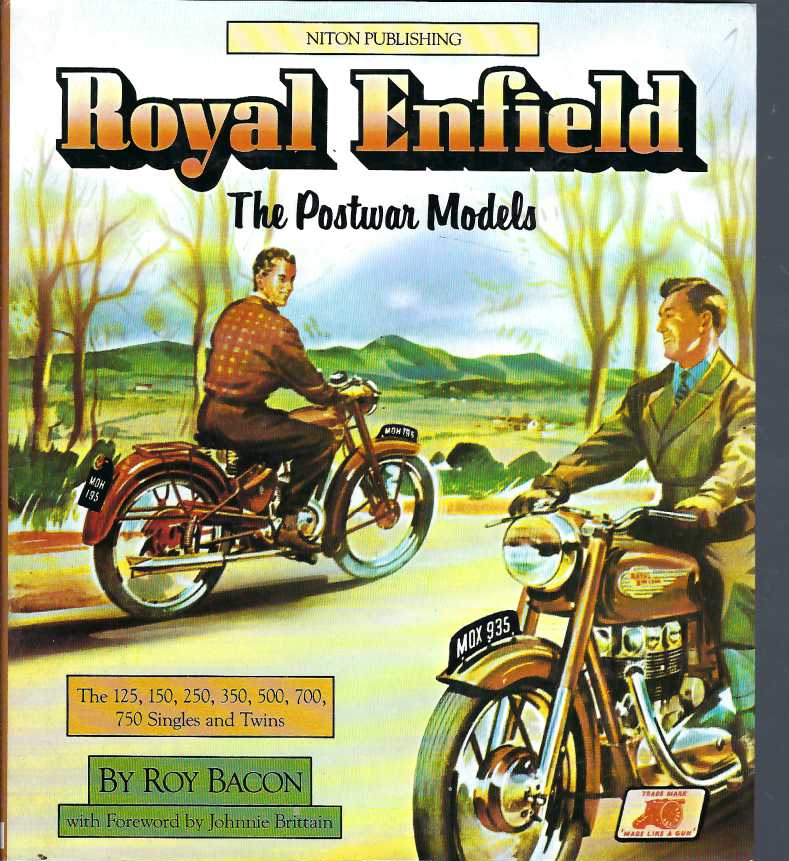MOTORCYCLES VINTAGE
pp. 192. illusts. #050822
Royal Enfield was a brand name under which The Enfield Cycle Company Limited of Redditch, Worcestershire[1] sold motorcycles, bicycles, lawnmowers and stationary engines which they had manufactured. Enfield Cycle Company also used the brand name “Enfield” without the “Royal”.
The first Royal Enfield motorcycle was built in 1901. The Enfield Cycle Company is responsible for the design and original production of the Royal Enfield Bullet, the longest-lived motorcycle design in history.
Royal Enfield’s spare parts operation was sold to Velocette in 1967, which benefitted from the arrangement for three years until their closure in early 1971. Enfield’s remaining motorcycle business became part of Norton Villiers in 1967 with the business eventually closing in 1978.
Postwar Model G and Model J and ex-military C and CO (1946–1954)
Postwar, Royal Enfield resumed production of the single cylinder ohv 350cc model G and 500cc Model J, with rigid rear frame and telescopic front forks. These were ride-to-work basic models, in a world hungry for transport. A large number of factory reconditioned ex-military sv Model C and ohv Model CO singles were also offered for sale, as they were sold off as surplus by various military services.[24]
In 1948, a groundbreaking development in the form of rear suspension springing was developed, initially for competition model “trials” models (modern enduro type machines), but this was soon offered on the roadgoing Model Bullet 350cc, a single cylinder OHV. This was a very popular seller, offering a comfortable ride. A 500cc version appeared shortly after. A mid 1950s version of the Bullet manufacturing rights and jigs, dies and tools was sold to India for manufacture there, and where developed versions continue to this day.[24]
500 Twins, Meteors, Super Meteors and Constellations 1949–1963
In 1949, Royal Enfields version of the now popular selling parallel twins appeared. This 500cc version was the forerunner of a range of Royal Enfield Meteors, 700cc Super Meteors and 700cc Constellations. Offering good performance at modest cost, these sold widely, if somewhat quietly in reputation. The 700cc Royal Enfield Constellation Twin has been described as the first superbike.[25]
250 cc models
The 250cc class was important in the UK as it was the largest engine which a ‘learner’ could ride without passing a test. In the late 1950s and early 1960s, Royal Enfield produced a number of 250 cc machines, including a racer, the ‘GP'[26] and a Scrambler, the ‘Moto-X’, which used a modified Crusader frame, leading link forks and a Villiers Starmaker engine.[27][28] The Clipper was a base-model tourer with the biggest-seller being the Crusader, a 248 cc pushrod OHV single producing 18 bhp (13 kW).
RE GT with flyscreen
RE GT with Avon Speedflow nosecone fairing
In 1965, a 21 bhp (16 kW) variant called the Continental GT, with red GRP tank, five-speed gearbox (which was also an option on the Crusader), clip-on handlebars, rearset footrests, swept pipe and hump-backed seat was launched. It sold well with its race-styling including a fly-screen resembling a race number plate which doubled as a front number plate mount.[29]
RE Turbo Twin
The Avon ‘Speedflow’ full sports fairing was available as an extra in complementary factory colours of red and white.[30]
Other variants were the Olympic[27] and 250 Super 5, notable for use of leading-link front suspension (all the other 250 road models had conventional telescopic forks) and the 250 ‘Turbo Twin’, fitted with the Villiers 247 cc twin cylinder two-stroke engine.
The Royal Enfield GP production-volume racer was first raced in the Manx Grand Prix in September, 1964. Developed in conjunction with Royal Enfield Racing Manager Geoff Duke[26] the first public appearance was at Earls Court Show in November, 1964. Using a duplex-tube frame, leading link forks and one-piece tank and seat unit, the 250cc two-stroke single engine was similar to other small capacity race machines offered from rivals Greeves, Cotton, DMW and particularly Villiers,[31][32] which provided the engines for these marques and many other manufacturers and bike-builders including the ‘Starmaker’ competition engine used for the Scorpion racer and Sprite scrambler.[27]
Royal Enfield Interceptor
Royal Enfield Interceptor motorcycle
During the onslaught of the Japanese motorcycle manufacturers in the late sixties and early seventies, the English factories made a final attempt with the 692cc Interceptor[33] in 1960[34][failed verification][failed verification] –1961[35][failed verification][failed verification] followed in 1962–1968[36][failed verification][failed verification] by the 736cc Series I and Series II Interceptors. Made largely for the US market, it sported much chrome and strong performance, completing the quarter-mile in less than 13 seconds at speeds well above 175 km/h (105 mph).[37] It became popular in the US, but the company was unable to supply this demand, which accelerated the demise of this last English-made Royal Enfield.[38]
The Redditch factory ceased production in 1967 and the Bradford-on-Avon factory closed in 1970, which meant the end of the British Royal Enfield. After the factory closed a little over two hundred Series II Interceptor engines were stranded at the dock in 1970. These engines had been on their way to Floyd Clymer in the US; but Clymer had just died and his export agents, Mitchell’s of Birmingham, were left to dispose of the engines. They approached the Rickman brothers for a frame. The main problem of the Rickman brothers had always been engine supplies, so a limited run of Rickman Interceptors were promptly built.[39]
Enfield Indians
From 1955 to 1959, Royal Enfields were painted red, and marketed in the US as Indian Motorcycles by the Brockhouse Corporation, who had control of the Indian Sales Corporation (and therefore Indian Motorcycles) and had stopped manufacturing all American Indians in the Springfield factory in 1953. But Americans were not impressed by the badge engineering, and the marketing agreement ended in 1960, and from 1961, Royal Enfields were available in the US under their own name. The largest Enfield ‘Indian’ was a 700 cc twin named the Chief, like its American predecessors.[40]
